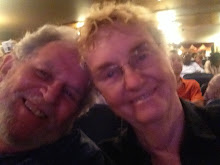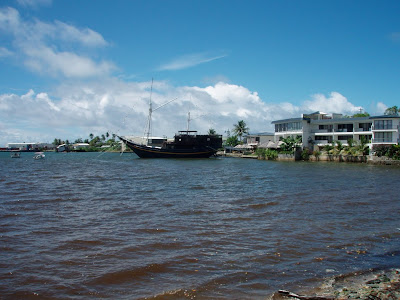

The women’s grass skirts are not made of grass, but of shredded leaves of ti, banana, betelnut, fragrant ginger, fern and other leaves. The women shown below, members of the elder’s village, are busy doing typical Yapese arts and crafts: basket weaving and lei making. The women are wearing traditional skirts. It takes many weeks to make each skirt because of the coloring (dyeing) of the leaves.

The village puts on displays of Yapese stick dancing to supplement the communities' income from the sale of their crafts and vegetables. The two film clips below are recordings of the village dancers. The dance took place just after a very heavy downpour of rain. They were supposed to dance on the path next to the large pieces of stone money that can be seen behind the dancers, but when the water rose to a level of six inches the dance was moved up onto the platform in front of the meeting house, and then continued during the next downpour of rain. The chanter is the older woman that you can catch glimpses of behind the dancers.
The picture below juxtaposes the two elements of Yapese society: the men dressed in traditional ‘thu’, betelnut bags under their arms, stopping to chat with a friend who was driving by on the main road in his new car.
Yap is probably best known for stone money—huge disks of crystalline stone, quarried on Palau and carried to Yap a century or more ago on open, ocean going canoes. The value of a piece of stone money is partially determined by its size, but also by the number of lives that were lost in bringing the stone money to Yap from Palau. The stone disks measure up to seven feet in diameter and weigh as much as four tons, making them the world’s largest currency. The stone money discs in the picture below are on the small side. The tree on the left that has white rings around it is a betelnut true, the source of the infamous betelnut that Yapese chew with great gusto!
A major part of the appeal of Yap is that it maintains many of its traditional characteristics. Stone paths wind through food producing landscapes of tree gardens and taro patch systems. Permission to walk on these paths should always be sought from someone in the village that owns the land.

Many come to Yap for the diving, especially the chance to glimpse the sight of one of the many manta rays gliding over the cleaning stations. The rays can reach a size of 15 feet across, and local divers have catalogued upwards of the 100 manta rays that cruise the waters around the Yap lagoon. The picture below is of the Manta Ray Bay (MRB) hotel from whence the largest number of diving expeditions sets forth. The old galleon was rescued by the owner of the MRB and turned into the hotel's restaurant. On Fridays, late afternoon-early evening, a movie screen is erected on the mast, and local teenagers are invited for a soft drink and movie night. It is great fun and the teens certainly seem to enjoy the chance to mingle socially outside of a school or village setting.
The voyage of the Hokule‘a from Hawai‘i in 2007 brought home to Satawal, one of Yap’s outer islands, a twin canoe, the Maisu, honoring the traditional navigator who led a revival of the ancient forms of Polynesian celestial navigation. Satawal is a low lying atoll that did not have secure moorage for the Maisu so it was then sailed to Yap where it is currently being used to teach a new generation of navigators. The picture below is of the Maisu docked in the harbor on Yap.

The Yapese, like the Palauans, carve storyboards and idols. The ‘Monkey Man’ is common to both islands, and one was pictured on the Palauan Blog. Early visitors to the Islands dubbed the Lios, or ‘spirit image’ from the island of Ulithi, an outer atoll of Yap, the “Monkey Man”. It is a protective spirit, most likely an ancestral image whose function it was to protect the family or relatives of the deceased. The function of such household spirits could change with context and this Lios might also be a guardian of dwellings or of spirit houses. Of the many types of Lios found in Micronesia, the so-called Monkey Man, carved from indigenous wood, is one of the most enduring. The picture below is of a Yapese Monkey Man that Sandra purchased, this time on Yap, a ‘brother’ for the one she purchased on Palau.
During a typhoon a couple of years ago, 80% of the schools were blown away; they just disappeared as if they never existed. Today the schools have been rebuilt and though supplies are in short supply the schools function well. Teachers are supported and children are energetic and happy attendees. Though the Yapese culture is hierarchal, in school children interact openly even if later on the playground children from a higher tribe might not speak with children of a lower tribe. In a similar fashion, children are not encouraged to ask question in social situations outside of the family, and so always speak softly when spoken to by adults. In school, they certainly ask questions and get quite verbally energetic. This is behavior most pronounced on Yap, but is characteristic of Micronesian children from other islands. When Micronesian children move to Hawai‘i or the mainland, they often display their ‘out of school’ behavior, that is, not speaking in front of adults, or speaking very softly when spoken to, and almost never asking questions. Mainland and Hawaiian teachers are well served if they recognize these behavior patterns, understand from whence they emanate, and gradually work with Micronesian children so they adopt more of the school behavior they experienced on their home islands.
So we now say ‘kamagar’ (thank you) to our Yapese friends, pack our bags for the second last time, get our weary bodies ready for the 4 am departure, and look forward to our time on the lands of the Chamorro people on Saipan and Guam.





No comments:
Post a Comment